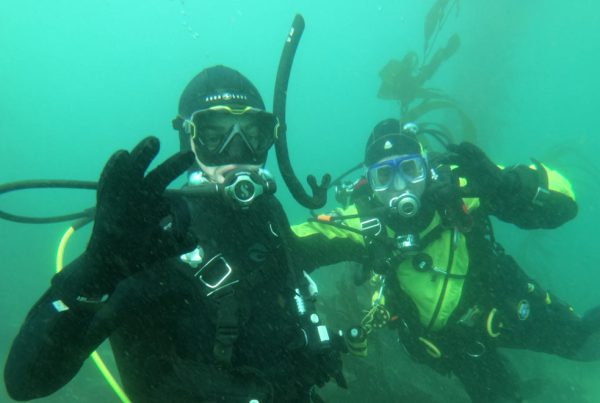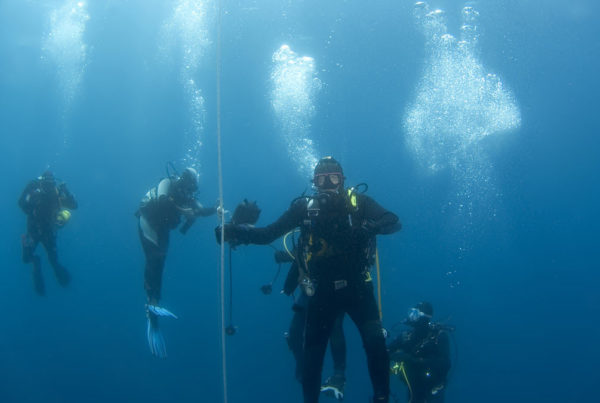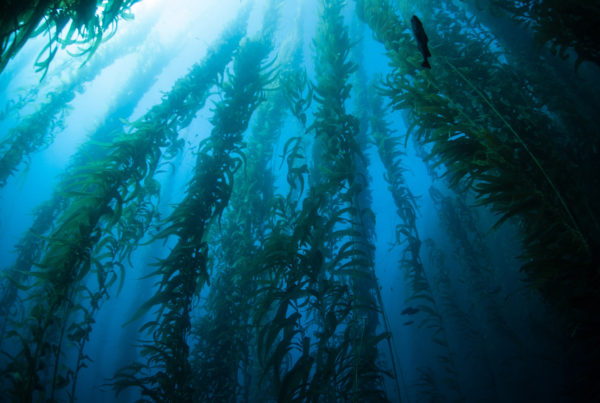In preparation for a dive, there are a number of things I’d like to know: surf, visibility, and temperature at depth. I can find surf information on-line, while visibility and temperature are presently not available. However, recent data released by the Catalina Conservancy Divers (CCD) indicate that there may be some hope to determine the temperature.
The CCD has an array of temperature devices deployed at multiple locations and depths about Santa Catalina Island. Temperatures have been recorded nearly continuously for the past 10 years. Recent studies relate those at-depth temperatures to the surface water temperatures measured by the nearest National Oceanic and Atmospheric Administration (NOAA) buoy. Using these results, a diver can access the current NOAA buoy temperature on-line and estimate the water temperatures at depth near Catalina. She can then modify her exposure suit appropriately and enjoy the dive.
Four locations at Catalina have thermographs recording temperatures at multiple depths. Consider the four locations as compass points. Temperatures are available at 15, 30, and 60 feet at three of those sites: West End, East End, and ocean-facing Little Harbor. The fourth site, USC Wrigley Institute for Environmental Studies, on the north side of the island has instruments at these depths plus one at 100 feet. The study found that at the same depth and time, temperature varied little among the four sites. However, the temperatures vary considerably from year to year. For instance, the winter water temperatures during an El Niño are much warmer than normal winter temperatures. Fortunately, the NOAA buoy records the same variations from year to year as seen in the at-depth temperatures, making it possible to infer from the buoy data the temperature likely to be encountered during a dive.
The figure shows the average temperatures for 15, 30, 60, and 100 feet for each day of the year. For shallow dives, the warmest time of the year is at the end of August and the beginning of September. However for deeper dives, it’s warmer from mid-September through mid-October. (It takes time for the warmth to make its way down to deeper water!) Likewise, the coolest time of the year for shallow dives is in March. At 100 feet, April is the coldest month. The greatest difference in temperatures between the depths occurs during the summer. In July, the water at 100 feet is 9 degrees colder than at 15 feet; that is, the temperature drops about 1 degree for every 10 feet in depth. In the winter months the water is less than 1.5 degree cooler at 100 feet than it is at 15 feet.
Also shown in the figure is the average surface temperature at the NOAA buoy. The NOAA buoy that was used is #46025, 43 miles to the northwest of Catalina, in the Santa Monica Basin. The surface water temperatures are very similar to the 30-feet water temperatures. Notice that during the winter months even the water at 60 feet is warmer than at the buoy. The colder temperatures at the buoy may be due to its proximity to the California Current which flows south bringing cold water to Southern California. This water eddies around the Channel Islands and warms in the process. On average, the water at 15 feet is always 1/2 to 1 degree warmer than the surface water at the buoy. Water at 30 feet is up to 1 degree warmer than the water at the buoy, except for the months of May through August. In those months the water is about 1/2 degree cooler. For convenience, consider the buoy and water to 30 feet deep as having the same temperature. During the winter, the water at 60 feet is a little warmer than at the buoy, but from May through October the water is up to 4 degrees cooler than at the buoy. The water at 100 feet is even colder.
You can estimate the temperature of your Catalina dive by first noting the difference between the buoy and your planned depth for the day using the data in the figure. Then access the current buoy temperature, apply the difference, and you will have a good prediction for the temperature you are likely to encounter. As an example, suppose you are planning to dive the underwater park in Avalon in July and will limit yourself to 60 feet. From the chart, you note that the average temperature in July at the buoy is 67 degrees and Catalina at 60 feet is 63 degrees. The difference is 4 degrees. If the actual buoy temperature for your dive day is 72 degrees, then you can expect to find a balmy temperature of 68 degrees. Likewise if the buoy temperature is 62 degrees, then you can expect the temperature at 60 feet to be a chilly 58 degrees.
So, if you’re planning a dive trip to Catalina first check the current surface water temperature at the NOAA buoy 46025 (http://www.ndbc.noaa.gov/station_page.phtml?station=46025) and then compensate for the depth difference. Add or subtract layers appropriately to your exposure suit. You’ll be glad you did!
The author thanks the CCD and especially Paul Meister for making the thermograph data available.
Average water temperature at Catalina and NOAA buoy 46025 during 1992-2001.









